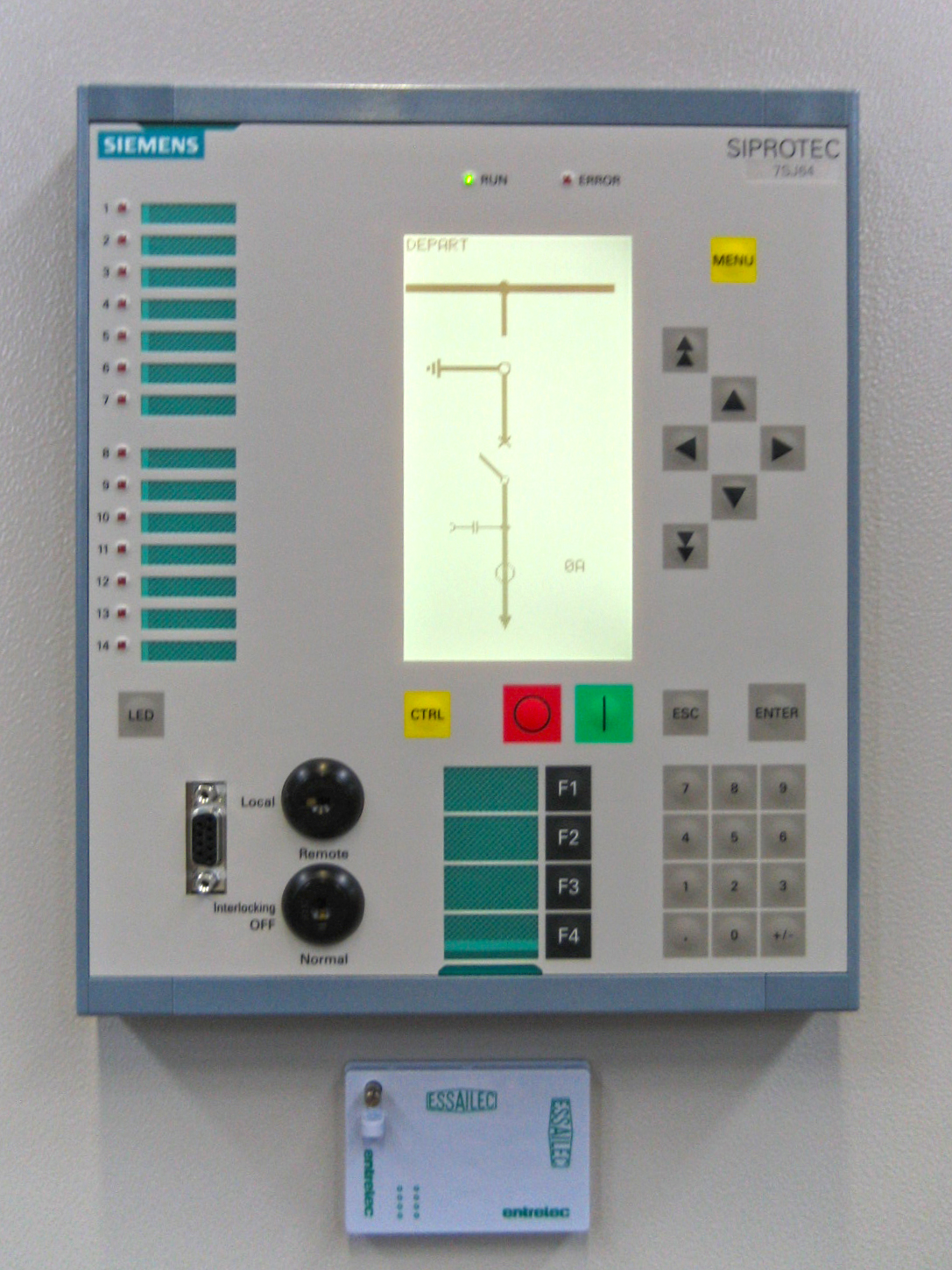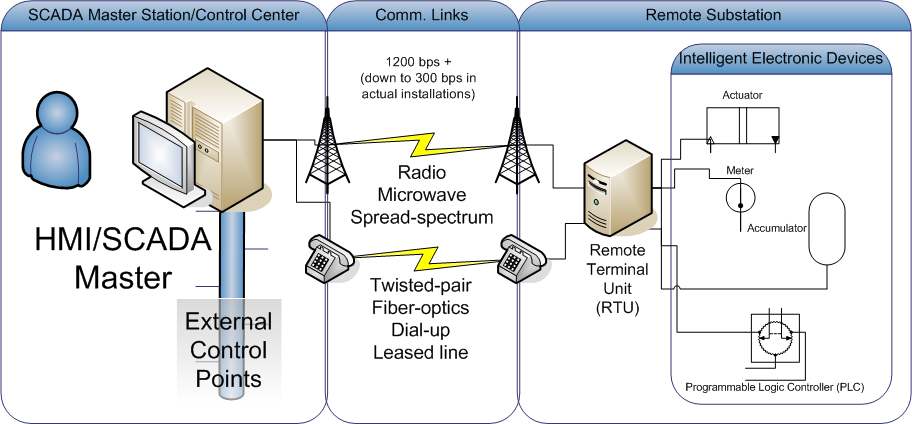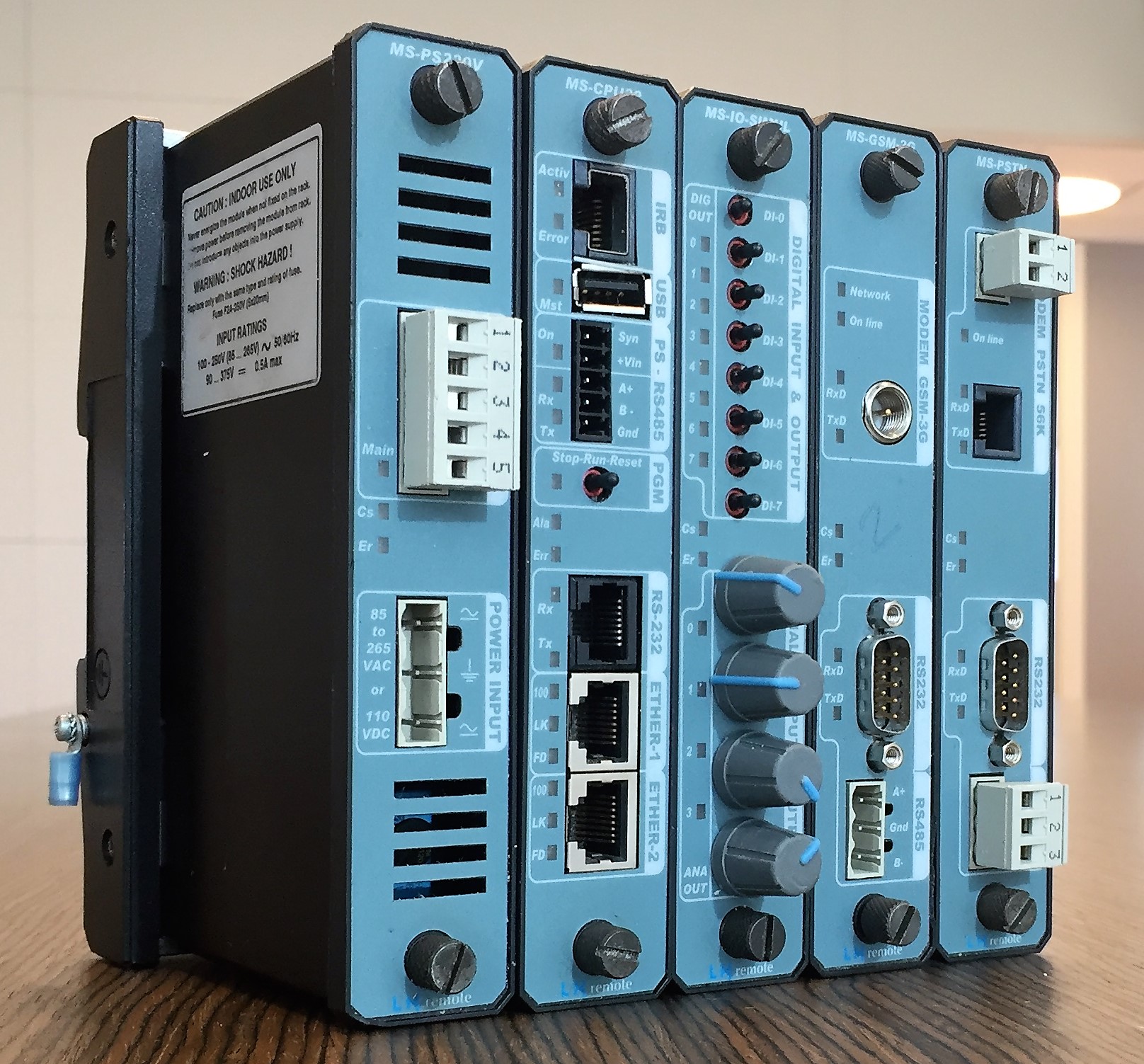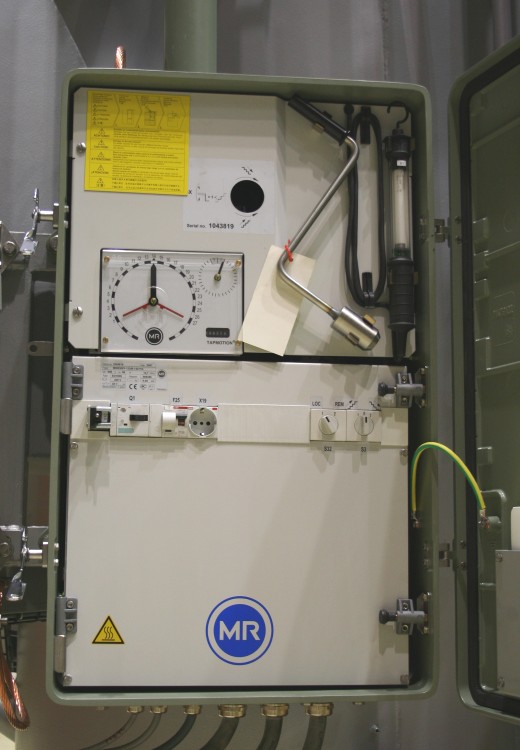|
Intelligent Electronic Device
In the electric power industry, an intelligent electronic device (IED) is an integrated microprocessor-based controller of power system equipment, such as circuit breakers, transformers and capacitor banks. Description IEDs receive data from sensors and power equipment and can issue control commands, such as tripping circuit breakers if they sense voltage, current, or frequency anomalies, or raise/lower tap positions in order to maintain the desired voltage level. Common types of IEDs include protective relaying devices, tap changer controllers, circuit breaker controllers, capacitor bank switches, recloser controllers, voltage regulators etc. This is generally controlled by a setting file. The testing of setting files is typically one of the most time-consuming roles of a protection tester. Digital protective relays are primarily IEDs, using a microprocessor to perform several protective, control and similar functions. A typical IED can contain around 5–12 protection functions ... [...More Info...] [...Related Items...] OR: [Wikipedia] [Google] [Baidu] |
Protective Relay
In electrical engineering, a protective relay is a relay device designed to trip a circuit breaker when a fault is detected. The first protective relays were electromagnetic devices, relying on coils operating on moving parts to provide detection of abnormal operating conditions such as over-current, overvoltage, reverse power flow, over-frequency, and under-frequency. Microprocessor-based solid-state digital protection relays now emulate the original devices, as well as providing types of protection and supervision impractical with electromechanical relays. Electromechanical relays provide only rudimentary indication of the location and origin of a fault. In many cases a single microprocessor relay provides functions that would take two or more electromechanical devices. By combining several functions in one case, numerical relays also save capital cost and maintenance cost over electromechanical relays. However, due to their very long life span, tens of thousands of these "sil ... [...More Info...] [...Related Items...] OR: [Wikipedia] [Google] [Baidu] |
Digital Protective Relay
In utility and industrial electric power transmission and distribution systems, a numerical relay is a computer-based system with software-based protection algorithms for the detection of electrical faults. Such relays are also termed as microprocessor type protective relays. They are functional replacements for electro-mechanical protective relays and may include many protection functions in one unit, as well as providing metering, communication, and self-test functions. Description and definition The digital protective relay is a protective relay that uses a microprocessor to analyze power system voltages, currents or other process quantities for the purpose of detection of faults in an electric power system or industrial process system. A digital protective relay may also be called a "numeric protective relay". It is also called numerical relay. Input processing Low voltage and low current signals (i.e., at the secondary of a voltage transformers and current transformers ... [...More Info...] [...Related Items...] OR: [Wikipedia] [Google] [Baidu] |
Programmable Logic Controller
A programmable logic controller (PLC) or programmable controller is an industrial computer that has been ruggedized and adapted for the control of manufacturing processes, such as assembly lines, machines, robotic devices, or any activity that requires high reliability, ease of programming, and process fault diagnosis. Dick Morley is considered as the father of PLC as he had invented the first PLC, the Modicon 084, for General Motors in 1968. PLCs can range from small modular devices with tens of inputs and outputs (I/O), in a housing integral with the processor, to large rack-mounted modular devices with thousands of I/O, and which are often networked to other PLC and SCADA systems. They can be designed for many arrangements of digital and analog I/O, extended temperature ranges, immunity to electrical noise, and resistance to vibration and impact. Programs to control machine operation are typically stored in battery-backed-up or non-volatile memory. PLCs were first devel ... [...More Info...] [...Related Items...] OR: [Wikipedia] [Google] [Baidu] |
SCADA
Supervisory control and data acquisition (SCADA) is a control system architecture comprising computers, networked data communications and graphical user interfaces for high-level supervision of machines and processes. It also covers sensors and other devices, such as programmable logic controllers, which interface with process plant or machinery. Explanation The operator interfaces which enable monitoring and the issuing of process commands, like controller set point changes, are handled through the SCADA computer system. The subordinated operations, e.g. the real-time control logic or controller calculations, are performed by networked modules connected to the field sensors and actuators. The SCADA concept was developed to be a universal means of remote-access to a variety of local control modules, which could be from different manufacturers and allowing access through standard automation protocols. In practice, large SCADA systems have grown to become very similar to distr ... [...More Info...] [...Related Items...] OR: [Wikipedia] [Google] [Baidu] |
IEC104
IEC 60870 part 5 Gordon R. Clarke et al, ''Practical modern SCADA protocols: DNP3, 60870.5 and related systems'', Newnes, 2004 is one of the IEC 60870 set of standards which define systems used for telecontrol (supervisory control and data acquisition) in electrical engineering and power system automation applications. Part 5 provides a communication profile for sending basic telecontrol messages between two systems, which uses permanent directly connected data circuits between the systems. The IEC Technical Committee 57 (Working Group 03) have developed a protocol standard for telecontrol, teleprotection, and associated telecommunications for electric power systems. The result of this work is IEC 60870-5. Five documents specify the base IEC 60870-5: * IEC 60870-5-1 Transmission Frame Formats * IEC 60870-5-2 Data Link Transmission Services * IEC 60870-5-3 General Structure of Application Data * IEC 60870-5-4 Definition and Coding of Information Elements * IEC 60870-5-5 Basic Appli ... [...More Info...] [...Related Items...] OR: [Wikipedia] [Google] [Baidu] |
DNP3
Distributed Network Protocol 3 (DNP3) is a set of communications protocols used between components in process automation systems. Its main use is in utilities such as electric and water companies. Usage in other industries is not common. It was developed for communications between various types of data acquisition and control equipment. It plays a crucial role in SCADA systems, where it is used by SCADA Master Stations (a.k.a. Control Centers), Remote Terminal Units (RTUs), and Intelligent Electronic Devices (IEDs). It is primarily used for communications between a master station and RTUs or IEDs. ICCP, the Inter-Control Center Communications Protocol (a part of IEC 60870-6), is used for inter-master station communications. Competing standards include the older Modbus protocol and the newer IEC 61850 protocol. History While IEC 60870-5 was still under development and had not been standardized, there was a need to create a standard that would allow interoperability between v ... [...More Info...] [...Related Items...] OR: [Wikipedia] [Google] [Baidu] |
Remote Terminal Unit
A remote terminal unit(RTU) is a microprocessor-controlled electronic device that interfaces objects in the physical world to a distributed control system or SCADA (supervisory control and data acquisition) system by transmitting telemetry data to a master system, and by using messages from the master supervisory system to control connected objects.Gordon R. Clarke, Deon Reynders, Edwin Wright,'' Practical modern SCADA Protocols: DNP3, 60870.5 and related systems'' Newnes, 2004 pages 19-21 Other terms that may be used for RTU are remote telemetry unit and remote telecontrol unit. Architecture An RTU monitors the field digital and analog parameters and transmits data to a SCADA Master Station. It runs setup software to connect data input streams to data output streams, define communication protocols, and troubleshoot installation problems in the field. An RTU may consist of one complex circuit card consisting of various sections needed to do a custom-fitted function, or may consi ... [...More Info...] [...Related Items...] OR: [Wikipedia] [Google] [Baidu] |
Electrical Substation
A substation is a part of an electrical generation, transmission, and distribution system. Substations transform voltage from high to low, or the reverse, or perform any of several other important functions. Between the generating station and consumer, electric power may flow through several substations at different voltage levels. A substation may include transformers to change voltage levels between high transmission voltages and lower distribution voltages, or at the interconnection of two different transmission voltages. They are a common component of the infrastructure, for instance there are 55,000 substations in the United States. Substations may be owned and operated by an electrical utility, or may be owned by a large industrial or commercial customer. Generally substations are unattended, relying on SCADA for remote supervision and control. The word ''substation'' comes from the days before the distribution system became a grid. As central generation stations became ... [...More Info...] [...Related Items...] OR: [Wikipedia] [Google] [Baidu] |
IEC61850
IEC 61850 is an international standard defining communication protocols for intelligent electronic devices at electrical substations. It is a part of the International Electrotechnical Commission's (IEC) Technical Committee 57 reference architecture for electric power systems. The abstract data models defined in IEC 61850 can be mapped to a number of protocols. Current mappings in the standard are to MMS (Manufacturing Message Specification), GOOSE (Generic Object Oriented System Event) ee section 3, Terms and definitions, term 3.65 on page 14 SV (Sampled Values) or SMV (Sampled Measure Values), and soon to Web Services. In the previous version of the standard, GOOSE stood for "Generic Object Oriented Substation Event", but this old definition is still very common in IEC 61850 documentation. These protocols can run over TCP/IP networks or substation LANs using high speed switched Ethernet to obtain the necessary response times below four milliseconds for protective relaying. S ... [...More Info...] [...Related Items...] OR: [Wikipedia] [Google] [Baidu] |
Tap Changer
A tap changer is a mechanism in transformers which allows for variable turn ratios to be selected in distinct steps. This is done by connecting to a number of access points known as taps along either the primary or secondary winding. Tap changers exist in two primary types, no-load tap changers (NLTC), which must be de-energized before the turn ratio is adjusted, and on-load tap changers (OLTC), which may adjust their turn ratio during operation. The tap selection on any tap changer may be made via an automatic system, as is often the case for OLTC, or a manual tap changer, which is more common for NLTC. Automatic tap changers can be placed on a lower or higher voltage winding, but for high-power generation and transmission applications, automatic tap changers are often placed on the higher voltage (lower current) transformer winding for easy access and to minimize the current load during operation. Tap changing No-load tap changer No-load tap changer (NLTC), also known as Off-c ... [...More Info...] [...Related Items...] OR: [Wikipedia] [Google] [Baidu] |
Electric Power Industry
The electric power industry covers the generation, transmission, distribution and sale of electric power to the general public and industry. The commodity sold is actually energy, not power, e.g. consumers pay for kilowatt-hours, power multiplied by time, which is energy. The commercial distribution of electricity started in 1882 when electricity was produced for electric lighting. In the 1880s and 1890s, growing economic and safety concerns lead to the regulation of the industry. What was once an expensive novelty limited to the most densely populated areas, reliable and economical electric power has become an essential aspect for normal operation of all elements of developed economies. By the middle of the 20th century, electricity was seen as a "natural monopoly", only efficient if a restricted number of organizations participated in the market; in some areas, vertically-integrated companies provide all stages from generation to retail, and only governmental supervision regul ... [...More Info...] [...Related Items...] OR: [Wikipedia] [Google] [Baidu] |
Frequency
Frequency is the number of occurrences of a repeating event per unit of time. It is also occasionally referred to as ''temporal frequency'' for clarity, and is distinct from ''angular frequency''. Frequency is measured in hertz (Hz) which is equal to one event per second. The period is the interval of time between events, so the period is the reciprocal of the frequency. For example, if a heart beats at a frequency of 120 times a minute (2 hertz), the period, —the interval at which the beats repeat—is half a second (60 seconds divided by 120 beats). Frequency is an important parameter used in science and engineering to specify the rate of oscillatory and vibratory phenomena, such as mechanical vibrations, audio signals (sound), radio waves, and light. Definitions and units For cyclical phenomena such as oscillations, waves, or for examples of simple harmonic motion, the term ''frequency'' is defined as the number of cycles or vibrations per unit of time. Th ... [...More Info...] [...Related Items...] OR: [Wikipedia] [Google] [Baidu] |





